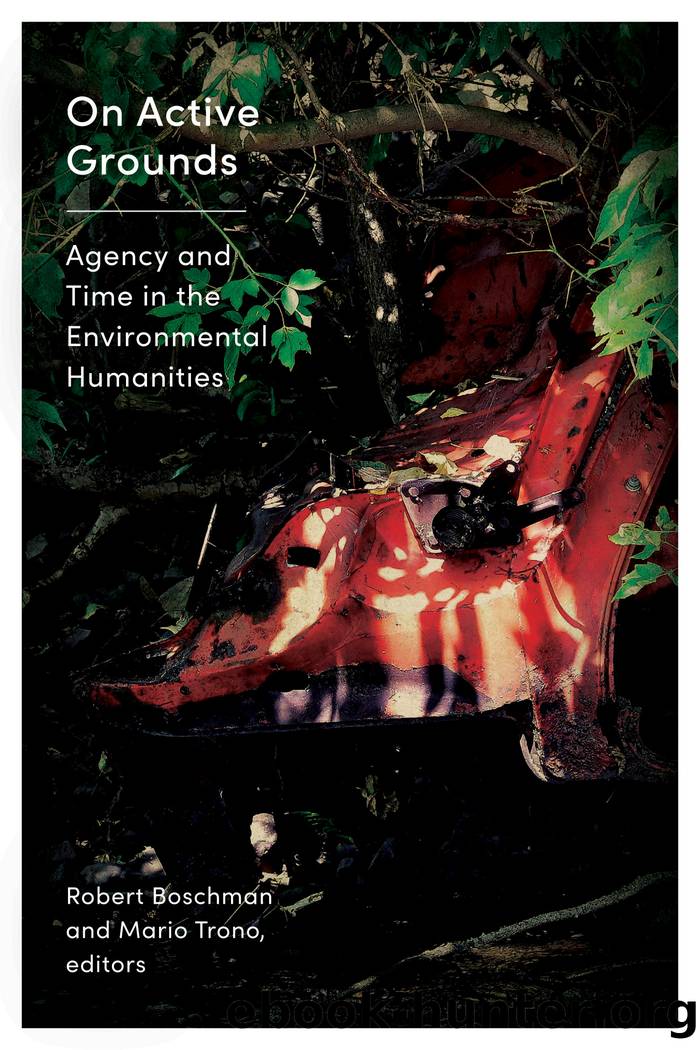On Active Grounds by Robert Boschman;Mario Trono;

Author:Robert Boschman;Mario Trono;
Language: eng
Format: epub
Publisher: Wilfrid Laurier University Press
Published: 2019-10-14T16:00:00+00:00
Fig. 6.10.âUMTRA disposal cell at Shiprock. Evaporation pond in background, San Juan River in foreground.
The crippling legacy of environmental racism faced by the people of the Indigenous Southwest is relatively unknown to North Americaâs general public. It is difficult for outsiders to grasp the cultural, economic, and environmental destruction these industries bring to Indigenous communities, or to comprehend the scale of the betrayal they have suffered at the hands of the US federal government and scheming corporations. Nor is it easy to understand many of the land use and economic policies that are sanctioned by the tribal governing bodies. The Navajo Nation and the tribal lands of the Southwest are isolated cultural ecologies that are bearing the brunt of US energy policy, economic impoverishment, corporate impunity, and widespread corruption.
Programs like the Navajo AML are under constant threat of losing funding, while managing as best they can to mitigate the environmental costs of mining. The Office of Surface Mining Reclamation and Enforcement is now attempting to eliminate all AML funding entirely. This will affect not only the Navajo but the Hopi and Crow as well. On-the-ground reclamation will stop, as will community infrastructure projects and technical assistance. The Navajo Nation is fighting the issue at the federal level, for congressional action will be required to amend the SMCRA in order to abolish the program. If funding is cut, the Navajo Nation will lose an important natural resource stewardship department that provides critical services to its people.
Sometimes, though, there are victories in the struggle for corporate accountability. Kerr-McGee was recently ordered to pay the highest ever compensation settlementâa record $5.15 billion to cover reclamation costs to address its toxic legacy of 80 years. Of that amount, $4.4 billion will be used to clean up toxic waste (Russia Today News 2014), including 50 AUMs and processing sites in and around the Four Corners area. The remaining three-quarters of a million dollars will go to compensate more than 8,000 individuals for health issues related to Kerr-McGeeâs mining and milling activities. The number of mining-related deaths is staggering. At the Shiprock uranium mine alone, 133 of the 150 Navajo miners employed there were dead from lung cancer or fibrosis by 1980 (Ali 2009, 2).
Many North Americans may not have heard of Kerr-McGee, unless they recall the name from the 1983 Mike Nichols film Silkwood. Karen Silkwood was a Kerr-McGee employee and anti-nuclear activist who had allegedly been exposed to radiation while working at one of its uranium-processing facilities. Silkwood died a mysterious death while en route to deliver documents containing records of Kerr- McGeeâs health and safety violations to a New York Times reporter. And Silkwood was only one of the many activists who have been battling the mining, energy, and defence sectors since the 1970s.
The many environmental justice and advocacy groups active in and around the Navajo Nation have formed a micro-political web that continues to grow, even while it suffers many setbacks. Its many threads may not have altered the dominant macro-political/corporate structure,
Download
This site does not store any files on its server. We only index and link to content provided by other sites. Please contact the content providers to delete copyright contents if any and email us, we'll remove relevant links or contents immediately.
Harry Potter and the Prisoner of Azkaban by J K Rowling(3510)
The Sentinel (Jack Reacher) by Lee Child & Andrew Child(3285)
Harry Potter and the Prisoner of Azkaban by Rowling J K(3073)
The Tales of Beedle the Bard by J.k.rowling (eng)(2700)
Dungeon Crawler Carl by Matt Dinniman(2119)
The Gate of the Feral Gods: Dungeon Crawler Carl Book 4 by Matt Dinniman(1949)
Marauder (The Oregon Files) by Clive Cussler & Boyd Morrison(1920)
Better Off Dead by Lee Child & Andrew Child(1893)
The Other Emily by Dean Koontz(1657)
Migrations by Charlotte McConaghy(1620)
The Girl and the Mountain by Mark Lawrence(1612)
Gild (The Plated Prisoner Series Book 1) by Raven Kennedy(1607)
Mark Z. Danielewski's House of Leaves by Mark Z. Danielewski & Johnny Truant(1514)
A Desolation Called Peace by Arkady Martine(1502)
Ruthless Empire (Royal Elite Book 6) by Rina Kent(1488)
Near the Bone by Christina Henry(1465)
The OP MC: God of Winning by Logan Jacobs(1429)
Fable: A Novel by Adrienne Young(1425)
The Captive by Fiona King Foster(1391)
